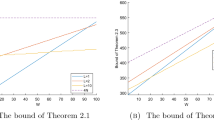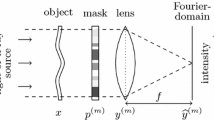Abstract
Digital signals are complex-valued functions on Z n . Signal sets with certain properties are required in various communication systems. Traditional signal sets consider only the time distortion during transmission. Recently, signal sets taking care of both the time and phase distortion have been studied, and are called time-phase signal sets. Several constructions of time-phase signal sets are available in the literature. There are a number of bounds on time signal sets (also called codebooks). They are automatically bounds on time-phase signal sets, but are bad bounds. The first objective of this paper is to develop better bounds on time-phase signal sets from known bounds on time signal sets. The second objective of this paper is to construct four series of time-phase signal sets, one of which is optimal.
Similar content being viewed by others
References
Allop, W.O.: Complex sequences with low periodic correlations. IEEE Trans. Inf. Theory 26(3), 350–354 (1980)
Bajwa, W.U., Calderbank, R., Mixon, D.G.: Two are better than one: fundamental parameters of frame coherence. Appl. Comput. Harmon. Anal. 33(1), 58–76 (2012) Preprint. arXiv:1103.0435v2 (2011)
Berndt, B.C., Evans, R.J., Williams, K.S.: Gauss and Jacobi Sums. Wiley-Interscience (1998)
Calderbank, A.R., Cameron, P.J., Kantor, W.M., Seidel, J.J.: Z 4-Kerdock codes, orthogonal spreads, and extremal Euclidean line-sets. Proc. Lond. Math. Soc. 75(3), 436–480 (1997)
Conway, J.H., Harding R.H., Sloane, N.J.A.: Packing lines, planes, etc.: packings in Grassmannian spaces. Exp. Math. 5(2), 139–159 (1996)
Ding, C.: Codebooks from combinatorial designs. IEEE Trans. Inf. Theory 52(9), 4229–4235 (2006)
Ding, C., Feng, T.: A generic construction of complex codebooks meeting the Welch bound. IEEE Trans. Inf. Theory 53(11), 4245–4250 (2007)
Ding, C., Yin, J.: Signal sets from functions with optimum nonlinearity. IEEE Trans. Commun. 55(5), 936–940 (2007)
Grassl, M.: Computing equiangular lines in complex space. In: Calmet, J., Geiselmann, W., Muller-Quade, J. (eds.) Beth Festschrift, LNCS 5393, pp. 89–104 (2008)
Gurevich, S., Hadani, R., Sochen, N.: The finite harmonic oscillator and its applications to sequences, communication and radar. IEEE Trans. Inf. Theory 54(9), 4239–4253 (2008)
Heath, R.W. Jr., Strohmer,T., Paulraj, A.J.: On quasi-orthogonal signature for CDMA systems. IEEE Trans. Inf. Theory 52(3), 1217–1226 (2006)
Helleseth, T., Kumar, V.P.: Sequences with low correlation. In: Pless, V.S., Huffman, W.C. (eds.) Handbook of Coding Theory, vol. II, pp. 1765–1853. Elsevier, Amsterdam (1998)
Herman, M.A., Strohmer, T.: High-resolution radar via compressed sensing. IEEE Trans. Signal Process. 57, 2275–2284 (2009)
Howard, S.D., Calderbank, A.R., Moran, M.: The finite Heisenberg-Weyl groups in radar and communications. EURASIP J. Appl. Signal Process. 2006 1–12 (2006)
Karystinos, G.N.: Optimum binary signature set design and short-data-record adaptive receivers for CDMA communications. Ph.D Thesis, University of New York at Buffalo (2003)
Kretschmer, F.F., Lewwis, B.L., Jr.: Doppler properties of polyphase coded pulse compression waveforms. IEEE Trans. Aero. Elec. Syst. 19(4), 521–531 (1983)
Levenstein, V.I.: Bounds on the maximal cardinality of a code with bounded modules of the inner product. Soviet Math. Dokl. 26, 526–531 (1982)
Li, W.C.W.: Number theory with applications. In: Series on University Mathematics, vol. 7 (1995)
Love, D.J., Heath, R.W., Strohmer, T: Grassmannian meamingforming for multiple-input multiple-output wireless systems. IEEE Trans. Inf. Theory 49(10), 2735–2747 (2003)
Nelson, J.L., Temlyakov, V.N.: On the size of incoherent systems. J. Approx. Theory 163, 1238–1245 (2011)
Renes, J.M., Blume-Kohout, R., Scott, A.J., Caves, C.M.: Symmetric informationally complete quantum measurements. J. Math. Phys. 45(6), 2171–2180 (2007)
Sarwate, D.: Meeting the Welch bound with equality. In: Proc. of the Sequences and their Applications, SETA’ 98, pp. 79–102. Springer, London (1999)
Scott, A.J., Grassl, M.: SIC-POVMs: a new computer study. J. Math. Phys. 51, 042203 (2010)
Sidelnikov, V.M.: On mutual correlation of sequences. Probl. Kibern. 24, 15–42 (1971)
Strohmer, T., Heath, R.W. Jr.: Grassmannian frames with applications to coding and communication. Appl. Comput. Harmon. Anal. 14(3), 257–275 (2003)
Welch, L.: Lower bounds on the maximum cross correlation of signals. IEEE Trans. Inf. Theory 20(3), 397–399 (1974)
Xia, P., Zhou, S., Giannakis, G.B.: Achieving the Welch bound with difference sets. IEEE Trans. Inf. Theory 51(5), 1900–1907 (2005)
Zauner, G.: Quantendesigns: Grundzuege einer nichtkommutativen Designtheorie. Dissertation, Universitaet Wien (1999)
Acknowledgements
This work was done while some of the authors were attending the Summer School for Mathematical Foundations of Coding Theory and Cryptography hosted by the Beijing International Center for Mathematical Research. The authors wish to thank the Center for its support in many aspects.
C. Ding is supported by the Hong Kong Research Grants Council under Project No. 601311. K. Feng and R. Feng are supported by the NSFC Grant No. 10990011. K. Feng is also supported by the Tsinghua National Lab. for Information Science and Technology. M. Xiong’s research was supported by the Hong Kong Research Grants Council under Project No. 606211 and DAG11SC02.
Author information
Authors and Affiliations
Corresponding author
Rights and permissions
About this article
Cite this article
Ding, C., Feng, K., Feng, R. et al. Unit time-phase signal sets: Bounds and constructions. Cryptogr. Commun. 5, 209–227 (2013). https://doi.org/10.1007/s12095-013-0085-y
Received:
Accepted:
Published:
Issue Date:
DOI: https://doi.org/10.1007/s12095-013-0085-y




